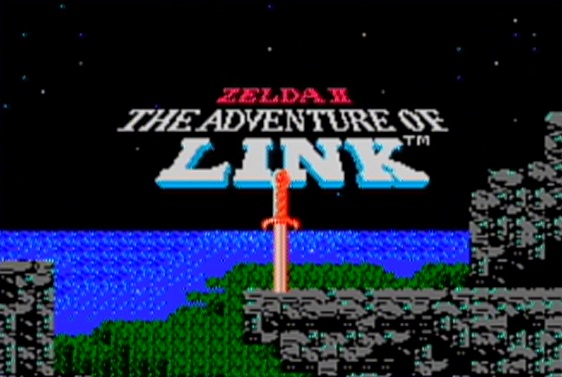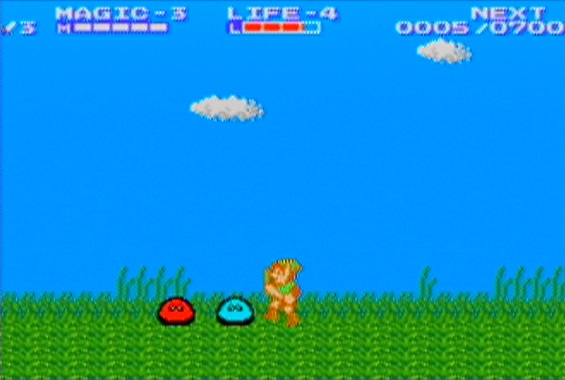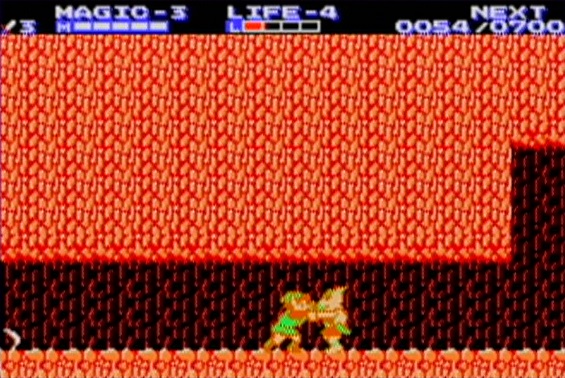Zelda II: The Adventure of Link

|
| Released in North America on December 1, 1988 by Nintendo, and developed by Nintendo R&D4, Zelda II: The Adventure of Link is the Zelda series' side-scrolling, action-RPG platforming black sheep. |
This is the one.
1988's Zelda II: The Adventure of Link stymied many a kid in the late 80's and early 90's, including me. Very much me. During that time period, I'd often find myself at some new kid's house, either because I was tagging along with my parents, or making a new friend from school. Invariably, I'd look to see if they had a NES by their TV. If they did, I'd dig through their games, and if I saw that golden Zelda II cartridge, I'd pop it in. What followed was generally embarrassing.

|
| Maybe I just wanted to see this legendary title screen |
I'd aimlessly run around the game's overworld map, run into a village, talk to NPC"s, have no clue how to progress, leave back to the overworld map, run into an enemy, and promptly die. Years after the NES, SNES, and N64 had come and gone, I purchased the Game Boy Advance port thinking college-age-me could finally competently play Zelda II. I couldn't make it to the second dungeon.

|
| Good thing this iconic imagery appears in the first five seconds of the game, otherwise I wouldn't have seen it until two weeks ago |
However, last month, I made a resolution: 2022 is the year I finally beat Zelda II: The Adventure of Link. No save states, no cheating. A guide is allowable, and that's it. I must beat the original, non-altered version of this game (ed. note, the version I just played through and beat is on the recently released Game & Watch: The Legend of Zelda, an exact port, and to prove that I beat this without save states (and didn't use codes either) I'll include a photo of the game's final screen at the end of this review). I'm happy to say: MISSION ACCOMPLISHED. And it's only February. Here's my take on this immensely difficult game, 35 years after its original release, and nearly 34 since its release in North America.

|
| Take that, overworld map! I'm not afraid of you anymore. |
Zelda II chronologically begins not long after its predecessor, 1986's The Legend of Zelda, ends. The evil Gannon has been defeated and peace has presumably returned to fantasy realm of Hyrule. However, a sleeping spell has been cast on Princess Zelda, and she can only be awakened if the series' hero, Link, returns six crystals to their rightful homes. Those "homes" just happen to be at the bottom of six ancient dungeon palaces spread beneath the kingdom of Hyrule. If the crystals are returned, Link will receive the Triforce of Courage, the final missing piece of the mythical Triforce. Link can then reunite the Courage piece with the Triforce pieces of Wisdom and Power recovered at the end of the first game. A reunited Triforce can grant the user's every wish, including "Please awaken Princess Zelda."

|
| I don't care how many of these innocent blobs I have to slaughter to wake her up!! |
The gameplay then follows a simple formula: fight your way through Hyrule's top-down viewed overworld to the closest town; figure out how to reach that town's wise man, likely by having to solve an esoteric puzzle in the town, or the surrounding overworld; find the nearby dungeon, fight your way through it, finding a new item along the way until you reach that dungeon's boss; defeat the boss, place a Crystal in the dungeon's base, return to the overworld, and head on to the next town. If an enemy touches you on the overworld map, you go to a small, side-scrolling stage and have to fight your way out. Dungeons are essentially enormous, labyrinthine side-scrolling stages. The game's extreme difficulty lies in both the sometimes absolutely opaque nature of what you are supposed to do in the aforementioned "non-action" segments of the game, and in the action/combat/platforming element that binds those segments together. For the former, a guide is absolutely necessary. For the latter, the necessity is practice.

|
| When it comes to stabbing a giant spider in a pitch-dark forest, practice makes perfect |
The way the difficulty level of both these elements intersects is complex. When the game starts the player off next to a sleeping Princess Zelda and says, "Okay go," you'll find all your levels at zero. Yes, levels. Unlike every single other Zelda game, the "RPG" in "action RPG" doesn't just derive from the way collecting more useful items and heart/life meter extenders makes Link more powerful. Here, it also derives from the fact that Link's attack power, defense level, and magic potency are all tied to leveling up, which is accomplished by defeating enemies to build up enough hit points. Each category is leveled up individually, and the higher the level, the more points needed to level up. The first few levels only require the player to acquire several hundred hit points...the higher levels require nearly 10,000 before each category maxes out at level eight.

|
| Give me those points, you damn cave beast! |
There are thankfully some sections, even early in the game, where you can grind to level up. However, if you run out of lives (this is the only Zelda game where "lives" is a feature) and get a game over, the amount of hit points you've accumulated goes back to zero. Thankfully, Zelda II allows the player to keep their levels, but if you were at the end of a dungeon with 6999 of the 7000 points needed to get your health to the next level, and the boss takes you out on your last life, all those points go bye-bye. And where do you restart after that game over? Right back next to the sleeping Zelda. That's right, if you were all the way across the map, you're sent right back to the start. Thankfully, the game saves everything you've accomplished and accumulated upon a game over, outside your hitpoints(The battery-backed saving this 35-year-old cartridge features makes it feel strangely modern), but unless you game over'd in Zelda II's final dungeon, The Great Palace, you'll start all the way back at the beginning of the map, and have to traverse the entire world map to get back wherever you were.

|
| No you're not! You're doing this...er, BEING this on PURPOSE!! |
And reaching those high levels? Level eights across the board are great for carelessly plowing back through the early parts of the map to get back where you were...but the latter portions of the map don't give a damn as to how high the level is next to your stats. They call it "Nintendo Hard" for a reason. This is one of the games for which that descriptor was created. And here's the puzzle-solving/combat difficulty intersection: early in the game, as you wander around, struggling to figure out what you're supposed to be doing, you'll be getting into fights and dying; late in the game, as you wander around, struggling to figure out what you're supposed to be doing, you'll be getting into fights and dying...because the skill and difficulty level of the enemies who live near The Great Palace have more than scaled with your own improvement. In fact, as hard as The Adventure of Link is overall, any previous difficult portions of the game pale in comparison to the final lava-filled stretch leading up to The Great Palace. Have I mentioned yet that you CAN and HAVE TO jump in this game? Yes, among all manner other things, The Adventure of Link is a platformer. Not only will you be dying at the hands of enemies--you'll be dying after falling into either bottomless, water, or lava-filled pits. Think a jump is clear? That enemy coming at laser speed from the opposite side of the screen doesn't think so. Whoops. You're dead.

|
| Your mirror? Your mirror?! Gannon's followers want to murder me in a ritualistic blood sacrifice!!! |
Thankfully, you can learn new moves from a couple of village warriors throughout the game to make jumping a little less perilous. There's a downward lunge that lets you stab and bounce off of any enemy that might wind up below you. There's an upward stab as well. Of course, figuring out how to find those warriors, as well as each village's spell-teaching wise man, is no easy task. Mirror Lady above? She's got a village wise man in her basement. Want to meet him? You've got to go to another random house in the village, crouch near a table and stab it. Viola. There's her stupid damn mirror. Common sense, right? Right?! That's why you should use a guide. Unless you want to play this game for a million years, the best way to actually derive enjoyment from Zelda II is to use a guide to get through the puzzle-solving portions of the game. The wise man in Mirror Lady's basement helps you to learn the health bar replenishing LIFE spell, which is integral to completing the game. Other times the spell you must learn, i.e. JUMP, is the only way to proceed through certain portions of the overworld map. Otherwise, you're just stuck staring at a cave exit that's too high to reach, unable to progress...like I was until two weeks ago.

|
| Wait...uh...how are you gonna help me in there?... |
As unfair as the game's puzzle difficulty feels, the actual combat and plaforming difficulty feels...fair? Do I just have Stockholm Syndrome? As much as I died in this game (at least I didn't break triple digits!), I did feel like I got better the more that I played. I mean, I beat this monstrosity, so I must have. As I got better, I started to see a lot more of the intentionality in this game, why certain items are placed where, why certain spells are taught at certain moments in the game. "GET GOOD" can be a truly annoying phrase to hear when you're constantly dying, but when you notice you actually are getting good at Zelda II, mastering when to duck and fight low, when to fight high, when to block...
 |
| When to stab blobs... |
This game's greatest test comes in that final cave and lava-filled mountainous path to The Great Palace. Here, you'll face extremely powerful and mobile enemies, dangerous jumps, and projectiles coming from seemingly every which way. Leveling each stat to eight, gaining every item, learning every spell and fight move, and finding every health and magic meter extension doesn't make this stretch of the game easy. Doing these things just gives the player more options in how they can tackle the Great Palace path. Dying so far away from Zelda's pyre and having to start back there again and again creates resolve--and that resolve is rewarded...not only by the epic feeling of finally reaching The Great Palace, which has its own unique musical theme (this game's music is the standard), but by the fact that for the first time in the game, if you get a game over, you can start somewhere besides that pyre: right at the start of The Great Palace.

|
| The entrances to all of the game's seven palace dungeons evoke a sense of awe |
And for me, at that point in the game, the strengths--the UNIQUE strengths--of Zelda II: The Adventure of Link started to become clear. This game's mystique, its sense of ancient danger is real. The sense that this is the FINAL quest in a kingdom and world with aeons upon aeons of history is palpable. Every time Link's feet touch the stone of a temple, that place feels mythical, connected to an unfathomable depth of history. In the complex Zelda timeline, excluding 2017's Breath of the Wild, The Adventure of Link remains last. This game is what comes after everything else. Despite it only being the second Zelda game released when it hit shelves in 1988, The Adventure of Link feels like the final test of skill, mettle, and will for the Hero of Time. Beyond the style of its gameplay, for its atmosphere, its mystery, the near spiritual level of suffering born by enduring its brutal difficulty, The Adventure of Link is unique among Zelda games. There's a reason The Legend of Zelda isn't included in this game's title, a reason it's called The Adventure of Link, and an incredibly intentional reason for the identity of The Adventure of Link's final boss. Due to the unintuitive, esoteric nature of its puzzles, The Adventure of Link is far removed from the upper tier of Zelda games. However, as a singular experience, a punctuation mark or epilogue for the entire series, The Adventure of Link is perfect.



Comments
Post a Comment